
The Ring Nebula is a planetary nebula in the northern constellation of Lyra. Such a nebula is formed when a star, during the last stages of its evolution before becoming a white dwarf, expels a vast luminous envelope of ionized gas into the surrounding interstellar space.

The Cat's Eye Nebula is a planetary nebula in the northern constellation of Draco, discovered by William Herschel on February 15, 1786. It was the first planetary nebula whose spectrum was investigated by the English amateur astronomer William Huggins, demonstrating that planetary nebulae were gaseous and not stellar in nature. Structurally, the object has had high-resolution images by the Hubble Space Telescope revealing knots, jets, bubbles and complex arcs, being illuminated by the central hot planetary nebula nucleus (PNN). It is a well-studied object that has been observed from radio to X-ray wavelengths.
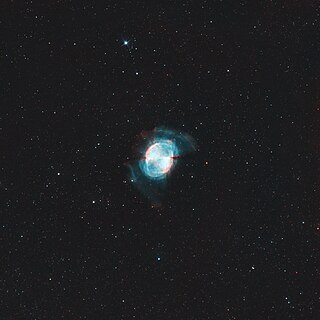
The Dumbbell Nebula is a planetary nebula in the constellation Vulpecula, at a distance of about 1360 light-years. It was the first such nebula to be discovered, by Charles Messier in 1764. At its brightness of visual magnitude 7.5 and diameter of about 8 arcminutes, it is easily visible in binoculars and is a popular observing target in amateur telescopes.

The Owl Nebula is a planetary nebula approximately 2,030 light years away in the constellation Ursa Major. Estimated to be about 8,000 years old, it is approximately circular in cross-section with a faint internal structure. It was formed from the outflow of material from the stellar wind of the central star as it evolved along the asymptotic giant branch. The nebula is arranged in three concentric shells, with the outermost shell being about 20–30% larger than the inner shell. The owl-like appearance of the nebula is the result of an inner shell that is not circularly symmetric, but instead forms a barrel-like structure aligned at an angle of 45° to the line of sight.
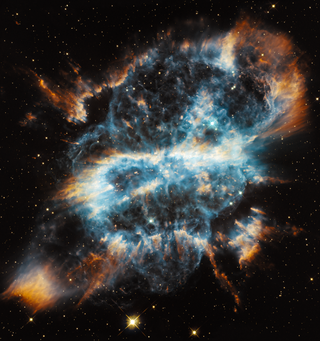
NGC 5189 is a planetary nebula in the constellation Musca. It was discovered by James Dunlop on 1 July 1826, who catalogued it as Δ252. For many years, well into the 1960s, it was thought to be a bright emission nebula. It was Karl Gordon Henize in 1967 who first described NGC 5189 as quasi-planetary based on its spectral emissions.
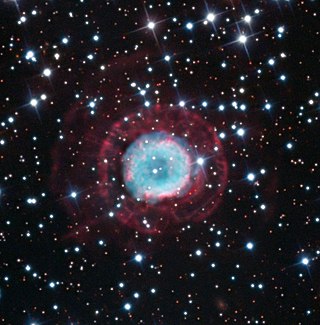
NGC 2438 is a planetary nebula in the southern constellation of Puppis. Parallax measurements by Gaia put the central star at a distance of roughly 1,370 light years. It was discovered by William Herschel on March 19, 1786. NGC 2438 appears to lie within the cluster M46, but it is most likely unrelated since it does not share the cluster's radial velocity. The case is yet another example of a superposed pair, joining the famed case of NGC 2818.

NGC 7027, also known as the Jewel Bug Nebula, is a very young and dense planetary nebula located around 3,000 light-years from Earth in the constellation Cygnus. Discovered in 1878 by Édouard Stephan using the 800 mm (31 in) reflector at Marseille Observatory, it is one of the smallest planetary nebulae and by far the most extensively studied.
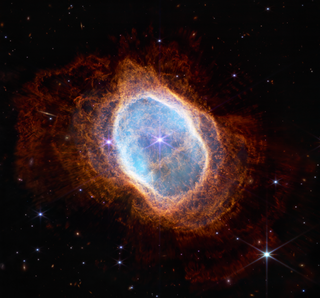
NGC 3132 is a bright and extensively studied planetary nebula in the constellation Vela. Its distance from Earth is estimated at about 613 pc. or 2,000 light-years.
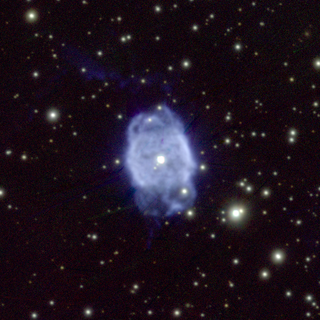
NGC 40 is a planetary nebula discovered by William Herschel on November 25, 1788, and is composed of hot gas around a dying star. The star has ejected its outer layer which has left behind a small, hot star. Radiation from the star causes the shed outer layer to heat to about 10,000 degrees Celsius and become visible as a planetary nebula. The nebula is about one light-year across. About 30,000 years from now, scientists theorize that NGC 40 will fade away, leaving only a white dwarf star approximately the size of Earth.

NGC 1514 is a planetary nebula in the zodiac constellation of Taurus, positioned to the north of the star Psi Tauri along the constellation border with Perseus. Distance to the nebula is 466 pc, according to GAIA DR2 data.

NGC 6302 is a bipolar planetary nebula in the constellation Scorpius. The structure in the nebula is among the most complex ever observed in planetary nebulae. The spectrum of NGC 6302 shows that its central star is one of the hottest stars known, with a surface temperature in excess of 250,000 degrees Celsius, implying that the star from which it formed must have been very large.

The Veil Nebula is a cloud of heated and ionized gas and dust in the constellation Cygnus.

NGC 2022 is a planetary nebula in the equatorial constellation of Orion, located at a distance of 8.21 kilolight-years from the Sun. It was first observed by William Herschel on December 28, 1785, who described it as: considerably bright, nearly round, like a star with a large diameter, like an ill-defined planetary nebula. In medium-sized amateur telescopes it looks like a small grayish patch of light. It is not very bright but it is still easy to spot it in the eyepiece. Even in a telescope as small as 80mm it can just be seen using a narrowband filter such as an OIII filter as a 'fuzzy' star. The object has the shape of a prolate spheroid with a major to minor axis ratio of 1.2, an apparent size of 28″, and a halo extending out to 40″, which is about the angular diameter of Jupiter as seen from Earth.

NGC 7635, also known as the Bubble Nebula, Sharpless 162, or Caldwell 11, is an H II region emission nebula in the constellation Cassiopeia. It lies close to the open cluster Messier 52. The "bubble" is created by the stellar wind from a massive hot, 8.7 magnitude young central star, SAO 20575 (BD+60°2522). The nebula is near a giant molecular cloud which contains the expansion of the bubble nebula while itself being excited by the hot central star, causing it to glow. It was discovered in November 1787 by William Herschel. The star BD+60°2522 is thought to have a mass of about 44 M☉.
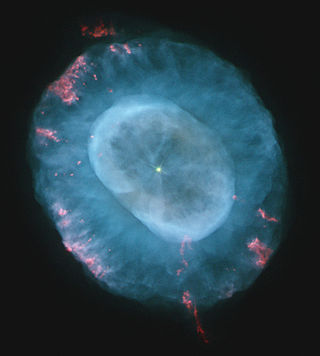
NGC 7662 is a planetary nebula located in the northern constellation Andromeda. It is known as the Blue Snowball Nebula, Snowball Nebula, and Caldwell 22. This nebula was discovered October 6, 1784 by the German-born English astronomer William Herschel. In the New General Catalogue it is described as a "magnificent planetary or annular nebula, very bright, pretty small in angular size, round, blue, variable nucleus". The object has an apparent visual magnitude of 8.3 and spans an angular size of 32″ × 28″. Parallax measurements give a distance estimate of 5,730 ± 340 ly (1,757 ± 103 pc).

NGC 2867 is an elliptical Type II planetary nebula in the southern constellation of Carina, just over a degree to the NNW of the star Iota Carinae. It was discovered by John Herschel on April 1, 1834. Herschel initially thought he might have found a new planet, but on the following night he checked again and discovered it had not moved. The nebula is located at a distance of 7,270 light-years from the Sun.
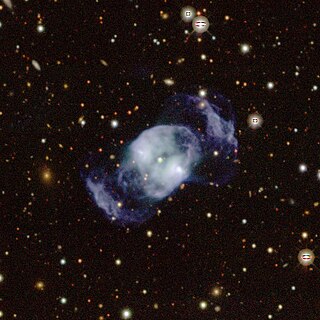
NGC 2371-2 is a dual lobed planetary nebula located in the constellation Gemini. Visually, it appears like it could be two separate objects; therefore, two entries were given to the planetary nebula by John Louis Emil Dreyer in the New General Catalogue, so it may be referred to as NGC 2371, NGC 2372, or variations on this name. It has also been called the double bubble nebula.

NGC 3242 is a planetary nebula located in the constellation Hydra.

IC 3568 is a planetary nebula that is 1.3 kiloparsecs away from Earth in the constellation of Camelopardalis. It is a relatively young nebula and has a core diameter of only about 0.4 light years. It was dubbed the Lemon Slice Nebula by Jim Kaler, due to its appearance in one false-colour image from the Hubble Space Telescope. The Lemon Slice Nebula is one of the most simple nebulae known, with an almost perfectly spherical morphology. The core of the nebula does not have a distinctly visible structure in formation and is mostly composed of ionized helium. A faint halo of interstellar dust surrounds the nebula. The central star of the planetary nebula is an O-type star with a spectral type of O(H)3.
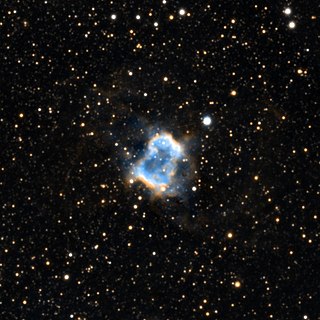
NGC 6445, also known as the Little Gem Nebula or Box Nebula, is a planetary nebula in the constellation Sagittarius. It was discovered by William Herschel on May 28, 1786. The distance of NGC 6445 is estimated to be slightly more than 1,000 parsecs based on the parallax measured by Gaia, which was measured at 0.9740±0.3151 mas.




















